#planigale
Explore tagged Tumblr posts
Text

Started off as a fur shading practice then ended up as a dasyuromorphia poster (hence everything being extremely not to scale). Love these animals :).
#mammal#mammals#marsupial#marsupials#dasyuridae#dasyuromorphia#dunnart#mulgara#planigale#ningaui#antechinus#phascogale#dasyure#numbat#tasmanian devil#quoll#scientific art#scientific illustration
93 notes
·
View notes
Text
Animal of the Day!
Long-tailed Planigale (Planigale ingrami)
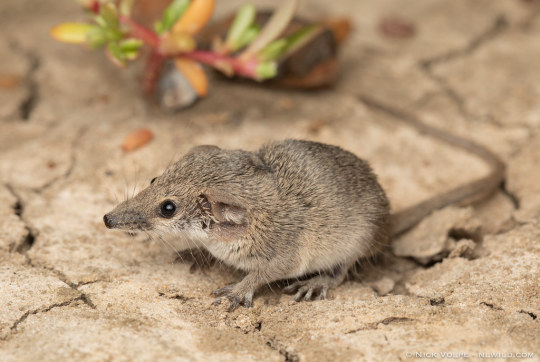
(Photo by Nick Volpe)
Conservation Status- Least Concern
Habitat- Northern Australia
Size (Weight/Length)- 4 g; 60 mm
Diet- Insects; Small mammals; Small reptiles
Cool Facts- Being the smallest marsupial in the world, the absolutely tiny long-tailed planigale lives a hard life. Being relatively fearless, the planigale will throw itself at anything from insects to small mammals. Biting repeatedly, the long-tailed planigale refuses to release its prey until it’s sure of a good meal. Preferring to live in woody areas with plenty of cover, it’s almost impossible to spot a long-tailed planigale in the wild despite their relative abundance. Females carry up to eight offspring in her tiny pouch, staying a total of three months with their mom.
Rating- 12/10 (Hard work for a single mom.)
#Animal of the day#Animals#Mammals#Marsupial#Friday#January 6#Long-tailed planigale#biology#science#conservation#the more you know
186 notes
·
View notes
Text
just for u pookie @yappacadaver
23K notes
·
View notes
Text
Time to infodump about the animals I'm supposedly a nerd about.

All pictures in this post are N. yvonneae, the southern ningaui (Image credit: Owen Lishmund)
The ningauis (in the genus Ningaui, if you can believe it) are a group of tiny dasyurid marsupials native to the arid and semi-arid regions of Australia. Smaller than their close dunnart relatives (very close, as I will explain later), and with broader hindfeet, ningauis were first documented by western science relatively recently by Australian mammal standards. Although some specimens had been collected previously, being haphazardly assigned to planigales (another genus of miniscule dasyurids), it wasn't until 1975 that the genus Ningaui was erected and its first two species were described - N. ridei, the Wongai ningaui, and N. timealeyi, the Pilbara ningaui. A third species, the southern ningaui (N. yvonneae), was named in 1983.
Oh, and in case you were wondering where the name "ningaui" comes from, it refers to tiny beings from Aboriginal mythology that come out at night, are covered in hair, have notably short feet and eat their food raw. Most of these traits are also shared by these little marsupials, hence why palaeontologist Mike Archer (the original author of the genus) found it to be a fitting name for them!

(Image credit: glandarius)
Ningauis are small - really small, some of the smallest land mammals in fact. With the tiniest individuals being only 5 cm long, not including the tail, they are about the same length as Australia's smallest native mammal, the long-tailed planigale. However, ningauis are significantly chunkier and therefore usually weigh a couple more grams, meaning planigales win in regards to all-around tininess. The very largest ningauis still only reach about 8 cm in length and 14 grams in weight.
What they lack in size they make up for in ferocity however, as they follow the typical dasyurid trend of becoming increasingly savage the smaller they get. Tasmanian devils, despite their reputation, are actually quite relaxed when handled - on the other end of the spectrum, ningauis, which are around a thousand times smaller than a devil, will try to murder you, your family and everyone you hold dear if they find themselves captured. But, despite their best efforts to chew the fingers off of every field mammalogist in inland Australia, they aren't very strong.

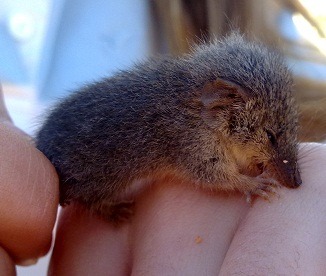
remorseless beasts (Image credit: Tina Gillespie & Miss.chelle.13)
These ferocious predators feed on a variety of different prey items, the majority of which are small invertebrates - in the case of the Wongai ningaui, they prefer prey that is less than a centimetre long. However, they will also go after larger prey, having epic duels with grasshoppers, spiders, centipedes and even small skinks which they subdue with a crushing bite to the back of the head. Unlike their dunnart relatives, the shorter, broader feet of ningauis allows them to climb into shrubs and grass clumps.
All ningaui species are extremely similar to one another, so much so that the Wongai ningaui and southern ningaui are almost externally indistinguishable and the Pilbara ningaui can only be told apart by looking at its foot pads, teat number and skull. However, they can usually be distinguished by distribution. The Pilbara ningaui is the most range restricted, being endemic to the central and western Pilbara region of western Australia. The southern ningaui occurs in three disjunct populations across the southern semi-arid zone, whilst the Wongai ningaui is distributed widely across much of the interior. All species show a strong preference for environments dominated by spinifex grass (Triodia), which they use as shelter.
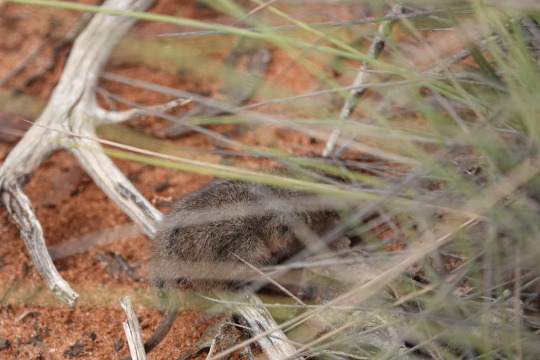
A ningaui takes shelter amongst the spinifex (Image credit: Euan Moore)
In regards to how they are related to other dasyurids, ningauis fall in the tribe Sminthopsini together with the kultarr (Antechinomys laniger, another species I really need to cover sometime) and many species of dunnart (Sminthopsis). However, recent phylogenetic studies have consistently recovered both Antechinomys and Ningaui as being within the Sminthopsis lineage, meaning that both ningauis and the kultarr are, in essence, just weird dunnarts. With Sminthopsis as we currently understand it being highly paraphyletic, a revision of the genus is needed.
#australian wildife#wildlife#mammal#marsupial#marsupials#ningaui#ningauis#animal facts#mammalogy#natural history#infodumps#my stuff
37 notes
·
View notes
Note

what animal you think i am!!! Tf a human is guys what the flip??
its so hard to find strictly one animal that feel like “You”- but i feel like some messed up fusion between a komodo dragon & a planigale is maybe pretty close…







10 notes
·
View notes
Note
your fursona is now a long-tailed planigale
I've never been to NT that's illegal
3 notes
·
View notes
Text
Planigales are so cute why is your head so flat...
1 note
·
View note
Text
Sminthopsis crassicaudata, Fat-tailed Dunnart
They got the booty, they doooo

Planigale ingrami, Long-tailed Planigale
*bites you* *bites you* *bites you* *bites you* *eats your soft fleshy parts and leaves the rest of you to rot*

Burramys parvus, Mountain pygmy possum
Life goals tbh. They eat until they've doubled their bodyweight and then hibernate for 5-7 months.

I’ve called you all here today to look at images of the secret marsupials they wouldn’t let us see in elementary school.
541 notes
·
View notes
Text
Tumblr Sexyman: Animal Edition
#tumblr sexyman#tumblr sexyman poll#animal sexyman#tumblr sexyman: animal edition#poll#polls#animals#snakes#frogs#cuttlefish#kangaroo#barnacle#quoll#marsupials
1 note
·
View note
Note
doot doot
also... worms????
HOORAY 4 DOOT DOOT 🎉🎉🎉🎉
Also my worms eat small Terrestrial mammals such as the American Shrew Mole & the Paucident Planigale btw just a friendly warning :)
0 notes
Text
i'm not religious but sometimes i see perfect little animals like this and think there must be a God



25 notes
·
View notes
Photo
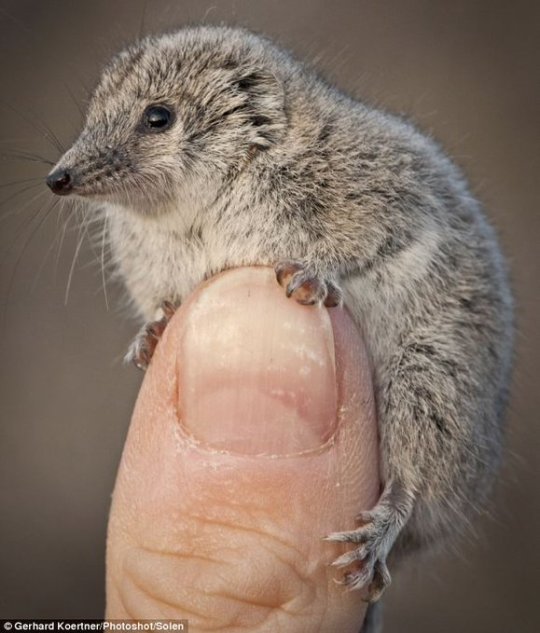
What’s this? An itsy bitsy Australian marsupial called a Giles' planigale.
8K notes
·
View notes
Photo

Tiny Tuesday
[x]
88 notes
·
View notes
Note
Your quirk would be that you could effect what's happening by writing about it. I mean like if there was a fight and a building was about to collapse you could write (or type) "no one gets hurt because somehow the rubble didn't hit anyone" and that's what would happen. You would probably have to be a little more specific though
Ooh thatd be so cool! It’d totally abuse it though, like “the test only had questions from the material my friend and I studied.” “my neighbour caught a cool animal in her trapping class because she just keeps getting nothing”
15 notes
·
View notes
Text
This year has been quite rich for new dasyurids - a couple months ago we were gifted with a two new planigale species from the Pilbara, and even more recently, a new paper by Newman-Martin et al. was released that found mulgaras, previously believed to be two species, are actually six. Tragically, the number of mulgara species out in Australia's deserts today remains two, as four of these species are already extinct.
But I'm getting ahead of myself. For someone who isn't a dasyuromorph disciple or other variety of Australian mammal nerd, what are mulgaras?

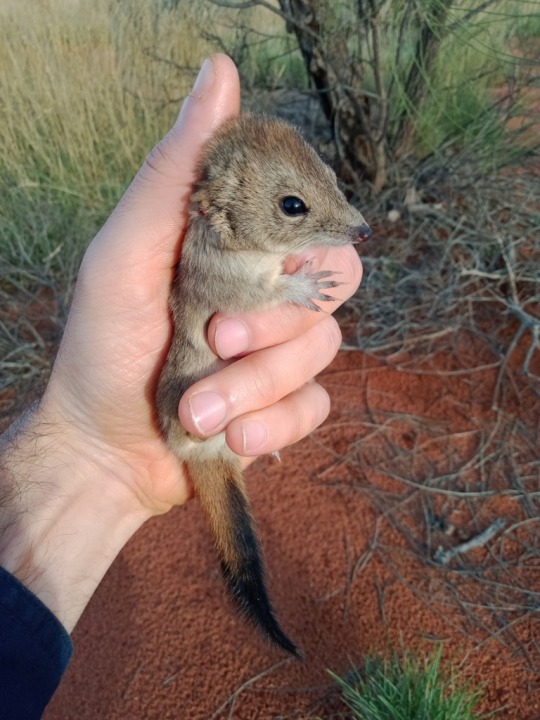
"Crest-tailed mulgara" on the left and "brush-tailed mulgara" on the right (Image credit: Yingyod Lapwong & Owen Lishmund)
Mulgaras (Dasycercus) are a genus of carnivorous marsupials in the family Dasyuridae, which includes Tasmanian devils, quolls and a huge variety of other smaller but equally vicious predators. A fair size as far as dasyurids go, these rat-sized mammals are specialists of arid and semi-arid environments and were previously widespread across much of inland Australia, but their distribution retreated deeper into the interior of the continent following European colonisation. One trait that sets them apart from other dasyurids is their burrowing prowess - while many dasyurid species will inhabit burrows dug by other animals, mulgaras are skilled diggers that will construct their own extensive burrow networks, complete with a main entrance and several side tunnels and pop holes.
Trying to figure out how many species of mulgara there are has always been a source of great confusion to mammal taxonomists. The first species described was Dasycercus cristicaudata back in the 1860s, followed by D. blythi and D. hillieri in the early 1900s. These two new species were synonymised with D. cristicaudata in 1988, leaving one species of mulgara. In 2000, mulgaras were split back into two species, D. cristicaudata and D. hillieri, but a 2006 study believed the species in question had been misidentified - what had been thought to be D. hillieri was actually D. cristicaudata, and what had been thought to be D. cristicaudata was actually D. blythi. Confused yet?

Dasycerus blythi (Image credit: Walter Baldwin Spencer)
Since then, the consensus has largely been that the two species of mulgara were the crest-tailed mulgara (Dasycercus cristicaudata) and the brush-tailed mulgara (D. blythi), both named after their distinctive tail shapes. However, the new paper turns this idea on its head yet again, with the most dramatic revision of Dasycercus species thus far.
Based on measurements of the teeth and skull, Newman-Martin et al. identified six different species within Dasycerus - this included D. cristicaudata and D. blythi, the previously invalidated D. hillieri, and three newly described species, D. wolleyae, D. archeri and D. marlowi. Despite this, the two previously identified living populations remained the only surviving species, with the other four being considered likely to be extinct based on their distribution. However, in one final twist, the surviving mulgaras previously considered to D. cristicaudata were found to actually be D. hillieri after all, meaning the type species of the genus is now among those believed to be extinct!
Of these species, three (D. cristicauda, D. hillieri & D. archeri) could be considered to be "crest-tailed" and two (D. blythi & D. marlowi) are "brush-tailed", while the sixth species, D. woolleyae, is usually crest-tailed but rarely brush-tailed. Given this, the appearance of the tail is no longer a distinctive characteristic of any of the species, but the authors stated that the common name could be kept for the extinct D. cristicaudata and potentially also the extant D. blythi. All other species required new common names, listed below:
Ampurta (Dasycercus hillieri)
Spinifex/brush-tailed mulgara (Dasycercus blythi)
†Crest-tailed mulgara (Dasycercus cristicaudata)
†Northern/sand mulgara (Dasycercus woolleyae)
†Southern mulgara (Dasycercus archeri)
†Little mulgara (Dasycercus marlowi)
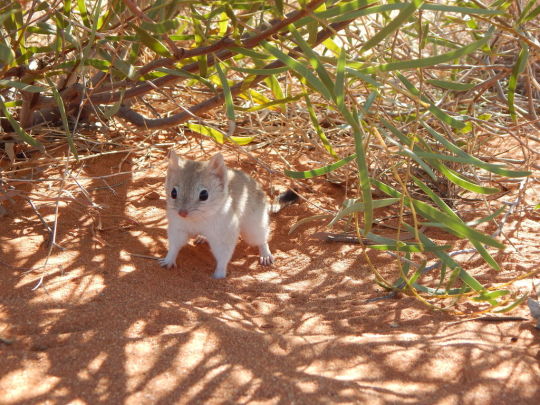
What was previously believed to be the crest-tailed mulgara, D. cristicaudata, is now the ampurta, D. hillieri! (Image credit: Mike Letnic)
The fact that four species of mulgara are now extinct is not only inherently disheartening, but these also represent the first known dasyurid species to have disappeared in modern times. Dasyurids were previously considered to be more resilient to the impacts of invasive species and habitat degradation than other small marsupials, hence why no species had yet been lost, but the discovery of extinct mulgaras demonstrates that we are likely underestimating the impact that European invasion has had on dasyurid diversity. There may well be many other species that have already gone extinct without us even realising they existed.
But, while more than half of the mulgaras are tragically now extinct, we must also appreciate the precious species that remain. The brush-tailed or spinifex mulgara thankfully remains widespread and common, but the ampurta now occurs in only a small portion of its former range and is considered to be vulnerable to extinction - we must take careful steps to protect this enigmatic little marsupial, unless we want to see Dasycercus lose yet another species in the not too distant future.
#australian wildlife#wildlife#mammals#marsupial#marsupials#mulgara#mulgaras#extinct#recently extinct#extinct species#extinction#animal facts#mammalogy#taxonomy#natural history#infodumps#my stuff
32 notes
·
View notes
Note
Are Quolls related to the Tasmanian Tiger or are they a different clade?
They're not super closely related. Actually, quolls are much more closely related to Tasmanian devils, they both belong to the clade Dasyurini!
Thylacines don't come into the picture until you zoom out to Dasyuromorphia, the clade that's essentially the marsupial equivalent of Carnivora in placental mammals. Quolls and Tasmanian devils are in here, but you'll also find weird guys like numbats and lots of little mousey things like dunnarts and planigales!

Left to right, top to bottom: Thylacine, Tasmanian devil, tiger quoll, numbat, yellow-footed antechinus, fat-tailed dunnart
231 notes
·
View notes